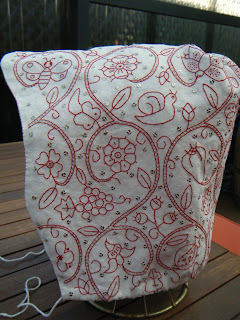The motifs are all taken from extant examples in Patterns of Fashion and also period pattern books like A Scholehouse for the Needle. This is not a very shaped coif, that is, the flaps over the ear areas are not very pronounced. This is a purely personal thing, as very shaped coifs don't really suit my round face.
The top edge of the coif is sewn together about two thirds of the way along and the last third is gathered up into a little knotted bunch. This makes a 'pouf' to allow for your bun or hair taping. The bottom edge is sewn into a channel for a cord which is used to slightly gather the bottom edge and tie up and over the hair to secure the coif. If you are planning on making this type of coif, I would suggest tapering the sides in so that the gathering channel is a bit less wide. Just how far you go will depend on where your bun or hair tapes sit. I misjudged on this pattern and the ties are too far forward which means that the coif doesn't sit properly over my hair. I would recommend making a test pattern up in waste fabric to test out different variations that will suit your face. It really can make the difference between a flattering and unflattering coif, especially if you are planning to wear it alone rather than under a flat cap or hat.
 |
| The pattern cut out and ready to be spangled |
 |
| The coif made up |
The embroidered coif that I am currently working on is smaller because I plan to wear it behind padded hair rolls and also because I have been gradually modifying my coif pattern to make it sit better and flatter my face more.
I draw my patterns out on tracing paper or lunch paper which I then tape to a window. Then I tape the linen or base fabric over the pattern and use the window as a big light box to transfer the patterns.

No comments:
Post a Comment